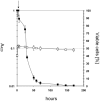Characterization of pyruvate uptake in Escherichia coli K-12
- PMID: 23818977
- PMCID: PMC3688616
- DOI: 10.1371/journal.pone.0067125
Characterization of pyruvate uptake in Escherichia coli K-12
Abstract
The monocarboxylate pyruvate is an important metabolite and can serve as sole carbon source for Escherichia coli. Although specific pyruvate transporters have been identified in two bacterial species, pyruvate transport is not well understood in E. coli. In the present study, pyruvate transport was investigated under different growth conditions. The transport of pyruvate shows specific activities depending on the growth substrate used as sole carbon source, suggesting the existence of at least two systems for pyruvate uptake: i) one inducible system and probably highly specific for pyruvate and ii) one system active under non-induced conditions. Using the toxic pyruvate analog 3-fluoropyruvate, a mutant was isolated unable to grow on and transport pyruvate. Further investigation revealed that a revertant selected for growth on pyruvate regained the inducible pyruvate transport activity. Characterization of pyruvate excretion showed that the pyruvate transport negative mutant accumulated pyruvate in the growth medium suggesting an additional transport system for pyruvate excretion. The here presented data give valuable insight into the pyruvate metabolism and transport of E. coli suggesting the presence of at least two uptake systems and one excretion system to balance the intracellular level of pyruvate.
Conflict of interest statement
Figures





Similar articles
-
BtsT, a Novel and Specific Pyruvate/H+ Symporter in Escherichia coli.J Bacteriol. 2017 Dec 20;200(2):e00599-17. doi: 10.1128/JB.00599-17. Print 2018 Jan 15. J Bacteriol. 2017. PMID: 29061664 Free PMC article.
-
Peptide Transporter CstA Imports Pyruvate in Escherichia coli K-12.J Bacteriol. 2018 Mar 12;200(7):e00771-17. doi: 10.1128/JB.00771-17. Print 2018 Apr 1. J Bacteriol. 2018. PMID: 29358499 Free PMC article.
-
Function and Regulation of the Pyruvate Transporter CstA in Escherichia coli.Int J Mol Sci. 2020 Nov 28;21(23):9068. doi: 10.3390/ijms21239068. Int J Mol Sci. 2020. PMID: 33260635 Free PMC article.
-
Pyruvate transport systems in organelles: future directions in C4 biology research.Curr Opin Plant Biol. 2016 Jun;31:143-8. doi: 10.1016/j.pbi.2016.04.007. Epub 2016 May 3. Curr Opin Plant Biol. 2016. PMID: 27153467 Review.
-
Polyamine uptake systems in Escherichia coli.Res Microbiol. 2001 Apr-May;152(3-4):271-8. doi: 10.1016/s0923-2508(01)01198-6. Res Microbiol. 2001. PMID: 11421274 Review.
Cited by
-
BtsT, a Novel and Specific Pyruvate/H+ Symporter in Escherichia coli.J Bacteriol. 2017 Dec 20;200(2):e00599-17. doi: 10.1128/JB.00599-17. Print 2018 Jan 15. J Bacteriol. 2017. PMID: 29061664 Free PMC article.
-
Characterization of LrgAB as a stationary phase-specific pyruvate uptake system in Streptococcus mutans.BMC Microbiol. 2019 Oct 12;19(1):223. doi: 10.1186/s12866-019-1600-x. BMC Microbiol. 2019. PMID: 31606034 Free PMC article.
-
A Single-Cell View of the BtsSR/YpdAB Pyruvate Sensing Network in Escherichia coli and Its Biological Relevance.J Bacteriol. 2017 Dec 5;200(1):e00536-17. doi: 10.1128/JB.00536-17. Print 2018 Jan 1. J Bacteriol. 2017. PMID: 29038258 Free PMC article.
-
Glucose-Limited Fed-Batch Cultivation Strategy to Mimic Large-Scale Effects in Escherichia coli Linked to Accumulation of Non-Canonical Branched-Chain Amino Acids by Combination of Pyruvate Pulses and Dissolved Oxygen Limitation.Microorganisms. 2021 May 21;9(6):1110. doi: 10.3390/microorganisms9061110. Microorganisms. 2021. PMID: 34063744 Free PMC article.
-
Expanding the substrates for a bacterial hydrogenlyase reaction.Microbiology (Reading). 2017 May;163(5):649-653. doi: 10.1099/mic.0.000471. Microbiology (Reading). 2017. PMID: 28488566 Free PMC article.
References
-
- Boeck A, Sawers G (1996) Fermentation. In: Neidhardt FC, Curtiss RI, Ingraham JL, Lin ECC, Low KB et al.., Escherichai coli and Salmonella. Washington, DC: ASM. 217–261.
-
- Kodaki T, Murakami H, Taguchi M, Izui K, Katsuki H (1981) Stringent control of intermediary metabolism in Escherichia coli: pyruvate excretion by cells grown on succinate. J Biochem 90: 1437–1444. - PubMed
-
- Kornberg HL, Smith J (1967) Genetic control of the uptake of pyruvate by Escherichia coli . Biochem Biophys Acta 148: 591–592. - PubMed
-
- Matin A, Konings WN (1973) Transport of lactate and succinate by membrane vesicles of Escherichia coli, Bacillus subtilis and a pseudomonas species. Eur J Biochem 34: 58–67. - PubMed
MeSH terms
Substances
LinkOut - more resources
Full Text Sources
Other Literature Sources
Molecular Biology Databases

